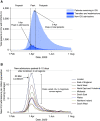Trends in Intensive Care for Patients with COVID-19 in England, Wales, and Northern Ireland
- PMID: 33306946
- PMCID: PMC7924583
- DOI: 10.1164/rccm.202008-3212OC
Trends in Intensive Care for Patients with COVID-19 in England, Wales, and Northern Ireland
Abstract
Rationale: By describing trends in intensive care for patients with coronavirus disease (COVID-19) we aim to support clinical learning, service planning, and hypothesis generation.Objectives: To describe variation in ICU admission rates over time and by geography during the first wave of the epidemic in England, Wales, and Northern Ireland; to describe trends in patient characteristics on admission to ICU, first-24-hours physiology in ICU, processes of care in ICU and patient outcomes; and to explore deviations in trends during the peak period.Methods: A cohort of 10,741 patients with COVID-19 in the Case Mix Program national clinical audit from February 1 to July 31, 2020, was used. Analyses were stratified by time period (prepeak, peak, and postpeak periods) and geographical region. Logistic regression was used to estimate adjusted differences in 28-day in-hospital mortality between periods.Measurements and Main Results: Admissions to ICUs peaked almost simultaneously across regions but varied 4.6-fold in magnitude. Compared with patients admitted in the prepeak period, patients admitted in the postpeak period were slightly younger but with higher degrees of dependency and comorbidity on admission to ICUs and more deranged first-24-hours physiology. Despite this, receipt of invasive ventilation and renal replacement therapy decreased, and adjusted 28-day in-hospital mortality was reduced by 11.8% (95% confidence interval, 8.7%-15.0%). Many variables exhibited u-shaped or n-shaped curves during the peak.Conclusions: The population of patients with COVID-19 admitted to ICUs, and the processes of care in ICUs, changed over the first wave of the epidemic. After adjustment for important risk factors, there was a substantial improvement in patient outcomes.
Keywords: COVID-19; United Kingdom; intensive care; mortality; trends.
Figures





Comment in
-
Learning from the First Wave of the Pandemic in England, Wales, and Northern Ireland.Am J Respir Crit Care Med. 2021 Mar 1;203(5):532-534. doi: 10.1164/rccm.202101-0089ED. Am J Respir Crit Care Med. 2021. PMID: 33476526 Free PMC article. No abstract available.
References
-
- WHO Director-General’s opening remarks at the media briefing on COVID-19: 11 March 2020. 2020 [accessed 2020 Jun 19]. Available from: https://www.who.int/dg/speeches/detail/who-director-general-s-opening-re....
-
- Center for Systems Science and Engineering. Baltimore, MD: Johns Hopkins University; 2020. Coronavirus COVID-19 global cases by the Center for Systems Science and Engineering (CSSE) at Johns Hopkins: 2020 June 19. [updated 2020 Dec 18; accessed 2020 Nov 16]. Available from: https://gisanddata.maps.arcgis.com/apps/opsdashboard/index.html#/bda7594....
-
- Wu Z, McGoogan JM. Characteristics of and important lessons from the coronavirus disease 2019 (COVID-19) outbreak in China: summary of a report of 72 314 cases from the Chinese center for disease control and prevention. JAMA. 2020;323:1239–1242. - PubMed
Publication types
MeSH terms
LinkOut - more resources
Full Text Sources
Other Literature Sources
Medical

